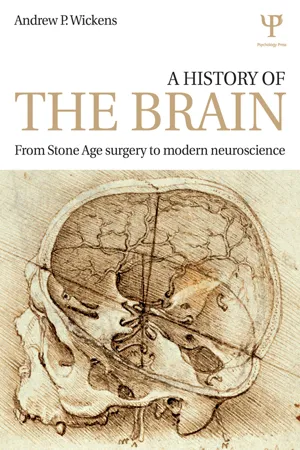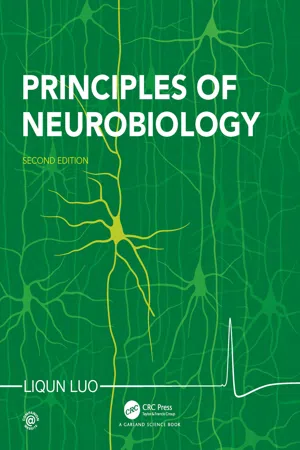Biological Sciences
Nerve Impulses
Nerve impulses are electrical signals that travel along the length of a nerve fiber. These impulses are generated by changes in the electrical charge of the cell membrane and are essential for communication within the nervous system. Nerve impulses allow for the transmission of information between different parts of the body, enabling sensory perception, motor control, and cognitive functions.
Written by Perlego with AI-assistance
Related key terms
Related key terms
1 of 4
Related key terms
1 of 3
7 Key excerpts on "Nerve Impulses"
- eBook - ePub
A History of the Brain
From Stone Age surgery to modern neuroscience
- Andrew P. Wickens(Author)
- 2014(Publication Date)
- Psychology Press(Publisher)
11SOLVING THE MYSTERY OF THE NERVE IMPULSEAll of science is either physics or stamp collecting .Earnest RutherfordIn 1933, while investigating the nervous system of the squid, I noticed certain transparent tubular structures of about a millimetre in diameter. At first I took them to be blood-vessels . . .John Zachary YoungSummaryThe nerve impulse, also known as the action potential, is crucial to our understanding of how the brain works. Your ability to consciously read these words; to reason and think; to laugh and cry; to engage in voluntary action, and much more, depends on millions upon million of tiny electrical impulses coursing through the axon fibres of your nervous system. Thus, if neuroscientists are ever to understand the brain, and how it produces the miracle of human behaviour, they will have to decipher this incredible cacophony of electrical information. However, as the twentieth century dawned, little was known about Nerve Impulses. At best, investigators knew the voltage inside the resting nerve cell was negative compared to its outside, and this difference momentarily reversed when an impulse passed down the axon. In fact, Emil Du Bois-Reymond referred to this as a ‘wave of relative negativity’, and its velocity estimated at around 27 metres per second by Hermann von Helmholtz in 1850. It was a speed implying the involvement of physiochemical events, although it would be another 50 years before a plausible theory emerged to account for it. This came from Julius Bernstein who explained the resting negativity of the neuron by attributing it to the unequal distribution of charged particles, called ions, existing between the cell’s interior and exterior. In turn, he hypothesised, the nerve impulse was created when the cell’s membrane temporarily ‘broke down’ allowing a transient flow of positively charged ions into the axon. It was an ingenious theory, although at the time there was no way of verifying the electrochemical events Bernstein had predicted. Further progress would have to wait until after the First World War, when new technology, including amplifiers and oscilloscopes were bought to bear on the problem. It was to result in what some have called the heroic age of neurophysiology, with vital contributions to our understanding of the action potential from a number of scientists who would become Nobel Prize laureates. The most important breakthrough came when the Oxford biologist John Zachary discovered the giant squid axon in 1936. This was sufficiently large enough for simple wires, or electrodes, to be implanted inside the nerve cell, allowing the fine currents of action potentials and their ionic correlates to be recorded. This endeavour would become most associated with the work of British physiologists Alan Hodgkin and Andrew Huxley, who published a series of precise mathematical equations describing the formation of the action potential in chemical and physical terms in 1952. Their explanation of the nerve impulse has never seriously been challenged since, and is widely recognised as the culmination of one of the greatest research endeavours in science, which began with Galvani’s discovery of animal electricity in 1791. - eBook - ePub
- Jim Barnes(Author)
- 2013(Publication Date)
- SAGE Publications Ltd(Publisher)
NEURONS, NEUROTRANSMISSION AND COMMUNICATIONCHAPTER OUTLINE How the nervous system is organised Cells of the nervous system The neuron Neuroglial cells Information exchange in the nervous system The resting membrane potential The action potential and nerve impulse Summation effects Synaptic transmission The synaptic vesicle Modulation of synaptic transmission Non-synaptic chemical communication Postsynaptic receptors and receptor types Neurotransmitters The amino acids Monoamines Acetylcholine Neuropeptides and neuromodulators Soluble gases Summary Further reading Key questionsThe purpose of biological psychology is to elucidate the biological mechanisms involved in behaviour and mental activity. Biological psychologists (sometimes referred to as neuropsychologists) attempt to understand how the neural circuits and connections are formed and put together during the development of the brain, allowing the individual to perceive and interact with the world around them. We cannot answer all of the questions that we would like to, nor do we believe that we have access to the best possible tools for studying the brain, but the questions do stir up curiosity and a better understanding of the biological processes that play a role in behaviour. It can be hard to remember the complicated names of nerve cells and brain areas. However, to develop theories of behaviour regarding the brain, a psychologist must know something about brain structure. This chapter will focus on the nervous system : its organisation, its cell composition, and the type of chemical signals that make it possible for us to process an incredible amount of information on a daily basis.HOW THE NERVOUS SYSTEM IS ORGANISEDIn vertebrates , the nervous system has two divisions: the peripheral nervous system and the central nervous system (Figure 1.1 ). The central nervous system (CNS), which consists of the brain and spinal cord, is surrounded by another nervous system called the peripheral nervous system (PNS). The PNS gathers information from our surroundings and environment and relays it to the CNS; it then acts on the signals or decisions that the CNS returns. The peripheral nervous system itself consists of two parts: the somatic nervous system and the autonomic nervous system . The autonomic nervous system is divided into two subsystems: the parasympathetic nervous system and the sympathetic nervous system . The parasympathetic system is responsible for slowing the heart rate, increasing the intestinal and gland activity and undertaking actions when the body is at rest. Its action can be described as opposite to the sympathetic nervous system, which is responsible for controlling actions associated with the fight-or-flight response. The somatic system contains the sensory receptors and motor nerves - Thomas P. Colville, Joanna M. Bassert(Authors)
- 2015(Publication Date)
- Mosby(Publisher)
This wave of sodium channels opening to allow sodium influx is called the wave of depolarization. As you recall, the strong influx of sodium ions during depolarization was called the action potential; therefore this wave of depolarization can also be called conduction of the action potential. In clinical terms, however, this wave of depolarization or conduction of the action potential along the cell membrane is most commonly called a nerve impulse. In the simplest terms, a nerve impulse is conducted along a nerve fiber by the “flipping” of the electric charges across the cell membrane (depolarization), followed quickly by the “unflipping” of the electric charges (repolarization). That process stimulates the adjacent area of the cell membrane in the direction of impulse conduction (remember that dendrites conduct impulses toward the cell body, and axons conduct impulses away from the cell body) to flip and unflip, which stimulates the adjacent area, and so on. If we were very tiny and could watch the cell membrane in one area of the neuron while a nerve impulse was being conducted, we could watch the flipping and unflipping of charges happen as the impulse passed by us. Regardless of how strong the initial stimulus was, if it were sufficient to achieve the threshold for a neuron to fire (depolarize), the nerve impulse (action potential) would be generated and conducted along the entire neuron with uniform strength. This phenomenon is called the all-or-nothing principle, because either the complete neuron depolarizes to its maximum strength, or it does not depolarize at all. This is an important concept! A nerve impulse is a nerve impulse is a nerve impulse. They are all basically the same. What makes one nerve impulse signify the color red, another represent a particular odor, and a third cause a muscle fiber to contract? It depends on where the impulse is going- eBook - ePub
Biology Trending
A Contemporary Issues Approach
- Eli Minkoff, Jennifer K. Hood-DeGrenier(Authors)
- 2023(Publication Date)
- CRC Press(Publisher)
A contractile protein found principally in muscle cells.NerveA bundle of axons outside the central nervous system.NeurogliaCells of the nervous system other than neurons.NeuronsSpecialized cells that conduct Nerve Impulses along their surface.NeurotransmitterAny chemical that transmits a nerve impulse from one cell to another.Node of RanvierThe thinning of the myelin sheath where two adjacent myelin cells meet.NorepinephrineA neurotransmitter that transmits impulses to postganglionic neurons of the sympathetic nervous system.OligodendrocyteA type of neuroglial cell with few branches, generally nutritive in function.ParkinsonismA neurological disorder involving degeneration of certain darkly pigmented brain cells (the substantia nigra), an insufficiency of dopamine, muscle tremors, and difficulty walking or initiating voluntary movement.Peripheral nervesNerves outside the brain and spinal cord.Pineal bodyA structure on the roof of the diencephalon of vertebrate brains that maintains circadian rhythms.PolarizedHaving opposite ends or surfaces differing from one another in electrical charge.Procedural learningLearning how to do things, a process that does not require the hippocampus and is not necessarily conscious.REMA sleep stage characterized by Rapid Eye Movements beneath the closed eyelids and associated with dreaming episodes. - Wanda Webb, Richard K. Adler(Authors)
- 2016(Publication Date)
- Mosby(Publisher)
Basically, the purpose of the neuron is to communicate, to send a “neural message.” In the peripheral nervous system (PNS) many neuromuscular (i.e., neuron to muscle fiber) transmissions take place. In the brain itself, most of the neurons conduct neural impulses to other neurons, which are clustered quite close together, providing a high neuronal density in the cerebrum. This high density creates an almost unlimited capacity for complex neuronal activity. This neuronal activity, or brain activation, produces sensations, perceptions and thoughts as well as nerve signals eventually resulting in voluntary muscle movement. Activation is the result of rapid biochemical and biophysical changes at the cellular level and in the neurons and glial cells of the brain. 6 In this chapter we examine this process very simplistically, looking at a basic communication process of neurons: the generation of an action potential (AP) for the types of neurons that conduct this straightforward type of firing pattern, an AP generated one spike at a time. We concentrate on learning the process through which this occurs. Once you understand the properties of neurons that enable this basic transmission, you will be better able to understand how other neurons may be different in their firing patterns. These other patterns are mentioned in this chapter, but further elucidation of these patterns is beyond the scope of this text- eBook - ePub
Clinical Neurophysiology: Basis and Technical Aspects
Handbook of Clinical Neurology Series
- (Author)
- 2019(Publication Date)
- Elsevier(Publisher)
The action potential is a regenerative electrical phenomenon observed on excitable cell membranes that allows the propagation of signals without attenuation. It is the cornerstone of neurophysiology. This chapter is a review of the action potential and its relationship to the signals that are studied in clinical neurophysiology. The first section traces the history of key scientific discoveries over the last 250 years that have led to our present-day understanding of the electrical properties of nerve and muscle. The second section considers the molecular and biophysical mechanisms that are responsible for the electrical potentials that can be measured across all eukaryotic cell membranes, but specifically in neurons, nerves, and muscle. Mechanisms underlying propagation action potentials within the nervous system are also examined. The concluding section is a brief overview of the normal “macroscopic” signals that are commonly recorded from the central and peripheral nervous system, and how they are derived from action potentials.Keywords
Action potential; Action potential propagation; Neuromuscular transmission; Saltatory conduction; Compound motor unit potential; Sensory nerve action potential; Motor unit potentialAbbreviationsACh acetylcholineAChR acetylcholine receptorAIS axon initial segmentAnk ankyrinsAP action potentialCa++calciumCAM cell adhesion moleculeCl-chlorideCMAP compound muscle action potentialCNS central nervous systemCV conduction velocityEcoG electrocorticographyEEG electroencephalographyEMG electromyographyEPSP excitatory postsynaptic potentialIPSP inhibitory postsynaptic potentialK+potassiumMF muscle fiberMU motor unitMUP unit potential - eBook - ePub
- Liqun Luo(Author)
- 2020(Publication Date)
- Garland Science(Publisher)
Signaling across SynapsesProcesses which go through the nervous system may change their character from digital to analog, and back to digital, etc., repeatedly.John von Neumann (1958), The Computer & the BrainIn this chapter, we continue to explore neuronal communication. We discuss first how arrival of an action potential at the presynaptic terminal triggers neurotransmitter release and then how neurotransmitters affect postsynaptic cells. This process, called synaptic transmission, results in information transmission from the presynaptic cell to the postsynaptic cell across the chemical synapse. In the context of studying postsynaptic reception, we will also introduce the fundamentals of signal transduction and study how synaptic inputs are integrated in postsynaptic neurons. Finally, we will discuss the electrical synapse, an alternative to the chemical synapse. Intercellular communication mediated by chemical and electrical synapses is the foundation of all nervous system functions.HOW DOES NEUROTRANSMITTER RELEASE AT THE PRESYNAPTIC TERMINAL OCCUR?
In Chapter 2 , we addressed the basic cell biological and electrical properties of neurons that are required to understand how molecules, organelles, and action potentials get to axon terminals. We now address the main purpose of these movements: to transmit information across synapses to postsynaptic targets, which can be other neurons or muscle cells. To illustrate general principles, we focus first on model synapses and neurotransmitter systems and then expand our discussion to other neurotransmitter systems.3.1 Arrival of the action potential at the presynaptic terminal triggers neurotransmitter releaseNeurotransmitters are molecules released by presynaptic neurons that diffuse across the synaptic cleft and act on postsynaptic target cells. The vertebrate neuromuscular junction (NMJ), the synapse between the motor neuron axon terminals and skeletal muscle, is a model synapse that has been used to understand basic properties of synaptic transmission, many of which were later found to apply to other synapses. The neurotransmitter at the vertebrate NMJ was identified in the 1930s to be acetylcholine (ACh) (Figure 3-1A ). An important advantage of studying the neuromuscular synapse is that the postsynaptic muscle cell (also called a muscle fiber) is a giant cell that can easily be impaled by a microelectrode for intracellular recording (see Section 14.21 for details); sensitive and quantitative measurement of synaptic transmission can be achieved by recording the resulting current or membrane potential changes in the muscle fiber. The NMJ is also an unusual synapse in that the motor axon spreads out to form many terminal branches that harbor hundreds of sites releasing ACh onto the target muscle. This property makes the NMJ a strong synapse that reliably converts action potentials in the motor neurons into muscle contraction (to be discussed in more detail in Section 8.1
Index pages curate the most relevant extracts from our library of academic textbooks. They’ve been created using an in-house natural language model (NLM), each adding context and meaning to key research topics.
Explore more topic indexes
Explore more topic indexes
1 of 6
Explore more topic indexes
1 of 4






